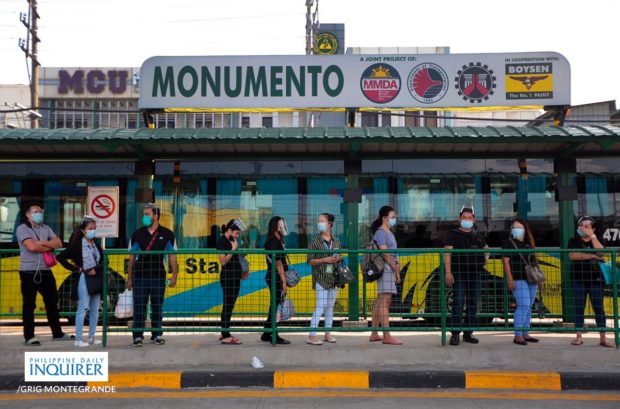
Commuters queue to ride the EDSA Bus Carousel in Monumento, Caloocan City on Wednesday, June 30.- INQUIRER FILE POTO/GRIG C. MONTEGRANDE
MANILA, Philippines — Disputing President Rodrigo Duterte’s claim that his government had “taken away the misery of public commuting,” a group advocating sustainable mobility said the country remained “plagued by a system-wide public transport shortage that had been made worse by the pandemic” and that commuters continued to face ‘dehumanizing’ conditions on the road.
Fact-checking the president’s last State of the Nation Address (Sona) delivered on Monday, the Move As One Coalition said that with the expiration of service contracting funds under the Bayanihan law, commuters are again forced to cope with even fewer trips on public transportation.
A social media post by the Antipolo City government last week showed public utility jeepneys overloaded with passengers despite a 50-percent capacity limit imposed to prevent Covid-19 transmission.
Pushing, shoving
“More than 70 percent of Filipino workers who cannot work from home have found it harder to get to work since the COVID-19 crisis began. This shortage has raised costs for commuters in the past year as road transport prices shot up by nearly 20 percent,” the group said, adding:
“It is dehumanizing to have to push and shove another person in order to get on a bus or jeepney, but the lack of public transport forces people to resort to desperate measures, otherwise they will not get to work on time, otherwise they might lose their job, otherwise their children might not eat that day.”
The Land Transportation Franchising and Regulatory Board (LTFRB) said last month that around 80 percent of PUV routes had been reopened, but according to the coalition, public transportation remained inadequate.
The government had managed to augment the shortage in public transportation when it started implementing the service contracting program last year, using the P5.58-billion budget from the Bayanihan 2 law.
When the law expired on June 30 and with the funding discontinued, the Department of Transportation (DOTr) was forced to suspend the service contracting program.
Apprehensions
Without this government support, the Move As One Coalition said, it became very difficult to control the number of passengers trying to get a ride, especially during rush hour.
“A driver cannot do much to force people to get off his vehicle; he just prays that he will not be apprehended,” the group said.
Instead of penalizing erring drivers or operators in such a predicament, government officials should “adopt a helpful and compassionate approach” on drivers who are already “hard-pressed to make ends meet after the government suspended their operations last year,” it said.
“Public transport supply is supposed to be sufficient, to accommodate the travel demand that is out there; but we all know that it is not,” it added.
In his final SONA on July 26, Duterte reported improvements in public transportation under his administration, like the upgrades of the Metro Rail Transit Line 3, the extension of the Light Rail Transit Line 2 and the opening of the Metro Manila Skyway – Stage 3.
“We have taken away the misery of public commuting,” he said, particularly noting the situation on Edsa.
But netizens were to dispute this claim, posting photos showing long lines forming at Edsa bus stops and terminals, as well as the heavy traffic congestion.